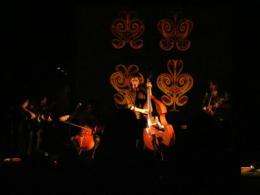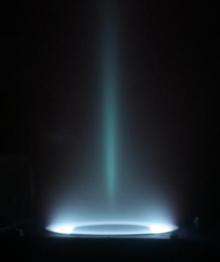Art of Science 2010 online gallery launches

Princeton University's fourth "Art of Science" exhibition -- featuring beautiful or otherwise interesting images created during the course of scientific research -- is now viewable online: http://www.princeton.edu/artofscience
"Since its inception in 2005, the Art of Science Competition has offered breathtaking pictures, surprise, and a new lens for scientific imagination," said Adam Finkelstein, associate professor of computer science and a co-organizer of the competition. "This year's exhibition comprises the strongest, most compelling imagery yet."
The theme of this year's exhibit is "energy," broadly defined.
The physical 2010 Art of Science exhibit opened May 7 with a reception in the main hall of the Friend Center on the Princeton campus and an outdoor concert by the orchestral rock band Miracles of Modern Science (MOMS), which performed the world premiere of their new song "Art of Science" as images from Princeton's past four Art of Science exhibits flashed behind in the night sky on a giant screen.
Jurors for the competition were President Shirley M. Tilghman; Dean of the Faculty David Dobkin, Phillip Y. Goldman '86 Professor in Computer Science; Paul Muldoon, Howard G.B. Clark '21 University Professor in the Humanities, director of the Princeton Atelier, and chair of the Lewis Center for the Arts; the photographer Emmet Gowin; and James Steward, director of the Princeton University Art Museum.
After this year's judging, Muldoon observed that with each new Art of Science exhibit "we're reminded, yet again, that art is less about the imposition of patterns on the world than an openness to the patterns the world imposes on us."
Cash prizes went to the top three winners of the competition: $250 for first place, $154.51 for second; and $95.49 for third. These amounts are derived according to the golden ratio, a mathematical proportion that has been found in aesthetically pleasing designs, from seashells to ancient Greek temples.
First place went to "Xenon Plasma Accelerator" by Jerry Ross, a postdoctoral researcher at the Princeton Plasma Physics Laboratory. Second place went to "Therapeutic Illumination" by David Nagib, a graduate student in chemistry at Princeton University. Third place went to "Neutron Star Scattering off a Super Massive Black Hole" by Tim Koby, an undergraduate majoring in physics at Princeton.
Co-organizer Andrew Zwicker, who is the head of Science Education at the Princeton Plasma Physics Laboratory (PPPL) and a lecturer in the Princeton Writing Program, said that the competition brings artists and scientists together in new and important ways.

"For a long time, science has informed art, providing new tools, new technology, and new inspiration," he said. "The interesting question raised by this competition is whether finding the beauty in a scientific image changes how that image is viewed scientifically - it may well be that the aesthetics on occasion inform the science."
The "Art of Science" organizers sought images that came directly from research in science and engineering. Princeton undergraduates, graduate students, faculty, research staff, community affiliates and alumni submitted microscopic images, photographs taken for purposes of field research and images generated by computer simulations, among other entries.
Provided by Princeton University

















